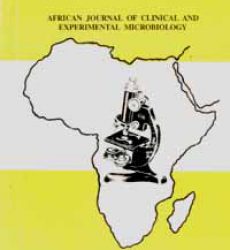Abstract
Background: Hypertension is a major health problem in sub-Sahara Africa. Several studies have suggested a role of asymptomatic bacteriuria (ASB) in the aetiology of hypertension, but there is a dearth of information on this association in Africa where the burden of hypertension is high. We investigated the prevalence of asymptomatic bacteriuria, its association with hypertension and determined the antibiotic resistance patterns of implicated bacterial isolates in an urban community of Ile-Ife.
Methods: One hundred and seventy-four apparently healthy individuals were investigated for ASB. Relevant information was obtained from them with standard proforma. Their Blood pressure was measured with a standard mercury sphygmomanometer. All samples were processed on cysteine lactose electrolyte deficient medium and chocolate agar. Antimicrobial susceptibility testing was done using Kirby-Bauer disk diffusion technique.
Results:Fifty (28.7%) individuals were positive for ASB. ASB was commonly detected among the female subjects (X2=5.619; p-value = 0.01777), and among individuals in the age group of 50 59 years. Those that were hypertensive were two and a half times more likely to have ASB (Odd ratio=2.5; p-value=0.01369; CI=1.19-5.35). The highest percentage of hypertensive female participants with ASB was found in the age group of 30-39 years (33.3%) while among the male participants, the highest percentage was found in the age group of 60-69 years (9.5%). Escherichia coli (n=13; 26%) and Staphylococcus aureus (n=13; 26%) were the commonest organisms implicated in ASB. The majority of the isolates (>90%) were multidrug resistant. Isolates of Escherichia coli were commonly resistant to ampicillin (83.3%), ceftriaxone (72.7%) and cefepime (66.7%). Isolates of Staphylococcus aureus were all (100%) resistant to erythromycin, cloxacillin and streptomycin. All isolates were least resistant to cotrimoxazole (<8%).
Conclusion: Women as well as men in the age group of 50-59 years were more likely to develop ASB. ASB could be contributing to the rising incidence of hypertension in this environment. Co-occurrence of hypertension and ASB portends a grave problem for apparently healthy individuals in this environment.
Keywords: Asymptomatic bacteriuria, Hypertension, Escherichia coli, healthy individuals, urban community
Download full journal in PDF below
Asymptomatic bacteriuria in an apparently healthy population and its relation to hypertension

